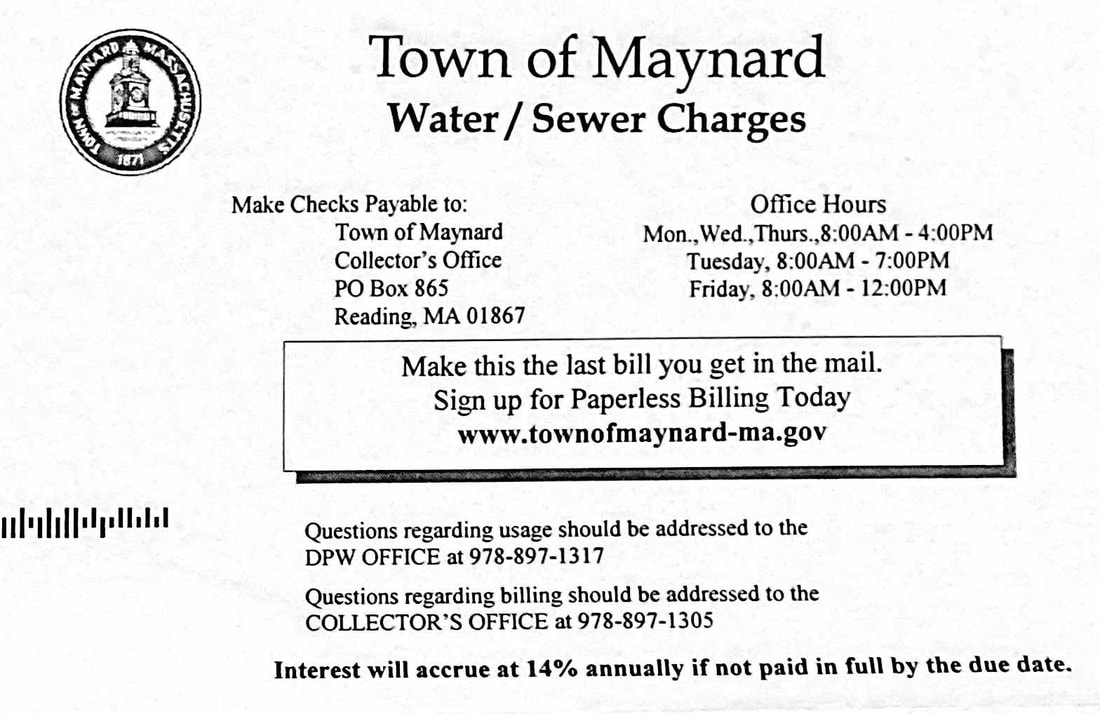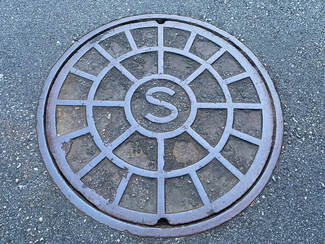|
by Glenn C. Koenig, webmaster at Town Wide Mall
The latest rates are documented on the Public Works Department web page: https://www.townofmaynard-ma.gov/213/Public-Works-DPW Under the heading "New Water/Sewer Rate Information" there are 5 links to various documents, but only the first one "Attested Copy ..." is in the form of a PDF document, and easiest to view on any computer. For simplicity, a copy can be downloaded here below.
The increase in rates depends on a number of complex factors, many of which are described by the Director of Public works in a memo sent to the Select Board previously, back in February. On the web site, it's in Microsoft Word format, but I have converted it to a PDF file, again for easier viewing, here.
The memo is 8 pages long, and lays out detailed reasons for the increase. It's quite a lot to read and digest, but from what I can gather after a quick review, there are at least three main reasons: • Inflation has increased the cost of labor, energy, and materials needed by the water department. • The infrastructure is aging and repair and replacement has been underfunded in the past, so we are playing "catch up" to prevent serious problems that could be caused by breakdowns and failures. • The town is close to the limit of capacity - we currently use almost all the water available to us. If the town wants to encourage any new development, such as more businesses or housing, more water will have to be made available before such development can go ahead. Years ago, for a variety of reasons, Maynard did not join the Massachusetts Water Resources Authority (the MWRA), the agency that supplies water and treats wastewater for many cities and towns in the greater metropolitan area, here in Eastern Massachusetts. In addition, negotiations with other adjoining towns to combine systems also did not prove fruitful. Therefore, we have a "stand alone" water and wastewater system, and must cover the full cost of operating it with income from water bills here in town.
Reading Maynard Water Bills When I first moved to Maynard, in 2019 and got my first water bill, I had trouble figuring out how the totals were calculated, based on the rate chart in the lower left corner. When I finally understood it, I made a short video to explain how it works. There is a link to it on the Energy Stories web site, but you can jump directly to it with this link, here: https://www.youtube.com/watch?v=BXkLAP1TmI4 It's just under 8 minutes running time. Saving Water and Money Maynard residents may be able to save water and reduce their bills by locating possible water waste in their homes. Contrary to popular belief, this may not involve any particular sacrifice (such as taking shorter showers). Merely finding leaks and appliances or fixtures that are wasting water could make a big difference. I have started a series of "how to" videos to help with this on my Energy Stories web site. https://energystories.org For example, even a toilet that doesn't leak can still waste significant water if it over-flushes. That is, if it uses more water per flush than it says on the label. This is surprisingly common and yet is something most people haven't ever considered. The problem is caused by the mechanism in the tank being serviced with the wrong replacement parts or from incorrect adjustment. I plan to post a video soon, to explain the details, and how to make repairs yourself for very little cost. Another example is low flow shower heads. They got a bad reputation decades ago when they were first introduced, but now there are plenty of models available that can conserve water, yet provide a comfortable showering experience. You can easily use your water meter to calculate how much water your shower uses, per minute. For details on how to read a water meter, see the link on the Energy Stories web site or use this link, here: https://vimeo.com/775387384 Comment To most of us, water is a simple matter. Just turn on the tap, flush the toilet, or run a laundry and the water necessary is there when we need it. Just as convenient is that fact that once we use that water, the wastewater that results disappears down the drain, almost always without a problem.
And yet, water is vitally necessary for our lives. Imagine how you'd feel if you turned on the tap and nothing came out. Or if you flushed the toilets and nothing went down. Yuk! This situation leaves us with very few options. To keep the system running we have to pay the price of maintaining it and save money to cover emergencies or possible hazards, such as ground water pollution from new unanticipated causes. For many years, water has been very inexpensive, so traditionally, most people have gotten used to just ignoring all this and get on with other things in life. Water from the town is still a bargain at roughly 1 cent per gallon. (Compare that with bottled water at the convenience store, which is about 10 cents per ounce, or well over $10 per gallon!).
Please consider making a donation to Town Wide Mall. Our only source of support is through you, our readers. This site is always available for anyone to read without charge; we have no advertising and no grant funding.
1 Comment
7/23/2023 07:51:54 am
As someone who has always live rurally I can attest Public water/sewer is still cheaper that owning a well, treatment facilities (softeners, aeration, radon removal etc,) and THEN the cost of septic. All these have 20-30 year costs that add up to more than my Maynard bills.
Reply
Leave a Reply. |
AuthorWrite something about yourself. No need to be fancy, just an overview. Archives
June 2024
Categories |
||||||||||||||||||||




 RSS Feed
RSS Feed